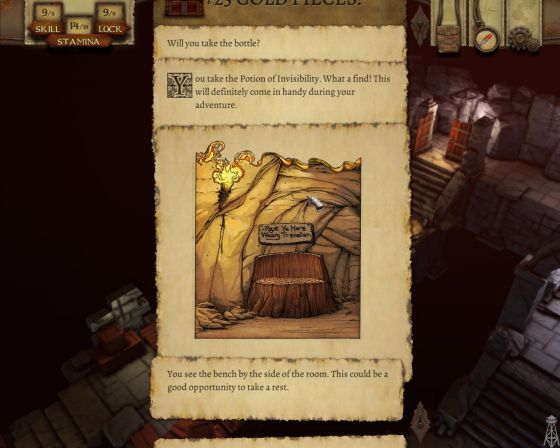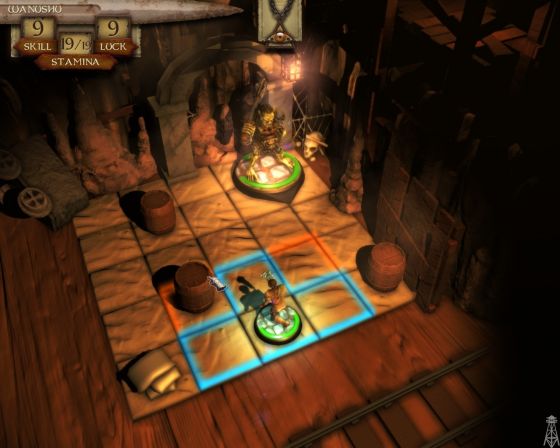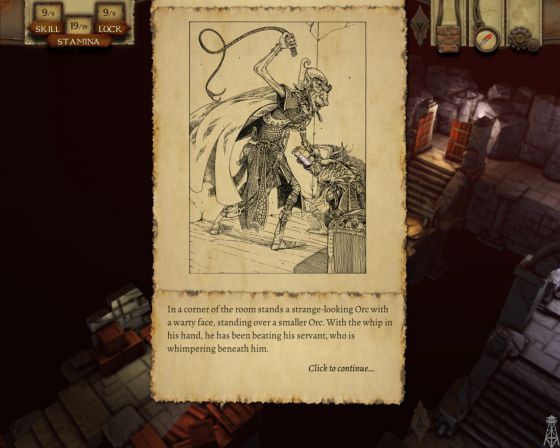The Warlock of Firetop Mountain Review

Background
Fighting Fantasy came into existence in 1982 when Steve Jackson and Ian Livingstone released the hugely influential original game-book "The Warlock of Firetop Mountain". The series distinguished itself from Choose Your Own Adventure by making "YOU" the hero and incorporating a simple role-playing system that used two dice replete with character defining statistics and rules for combat. Even as early as 1984, attempts were made at bringing these books into the world of video games, with several famous titles being made for systems at the time such as the C64 and ZX Spectrum.
Fighting Fantasy declined in popularity in the mid-90s but rose again via the Wizard Books relaunch of the brand starting in 2002. The books remain formative role-playing experiences for many fans around the world.
Teleport directly into the modern day - the series has had a reimagining or rebirth of sorts via companies such as Inkle and TinMan games releasing game versions of classic titles such as the Sorcery! series, House of Hell and Forest of Doom, effectively reinterpreting game-book experiences for new and old audiences alike.
Citadel of Chaos from the Commodore 64
In November 2015, TinMan Games created a Kickstarter project to fund their vision for a new imagining of the original classic "The Warlock of Firetop Mountain". After raising $54,676 and meeting four stretch goals, the company dutifully went to work, aiming also to create additional content in bringing Zagor's illustrious labyrinth to life. Thus, here were are now, with the result of their labors installed on my PC. So what is it like?
Character selection and attributes
The game blends classic Fighting Fantasy style narration, overleafing small pockets of text for storytelling and uses detailed tabletop miniatures to represent your character. Lush background features of the dungeon fall into place to show what can be seen as your party moves through the mountain.
It is the strikingly successful and charming merging of worlds which brings to life the dreams of many life-long Fighting Fantasy fans wishing for a modern video game in this capacity.
In addition to the regular statistics of skill, stamina and luck, each character figurine is further defined by two attributes which deepen role-playing themes and shape their dialogue reactions throughout the dungeon. Attributes include illiteracy, keen sight, fearsome presence, righteous, educated, dexterous, lucky, oversized and Orcish. Scripted encounters can often change or give other options, depending on the character you've chosen and what attributes they may have.
The essential gameplay stems from making choices of direction on the journey through the dungeon, interacting with the many encounters and locations preserved from the book, finding items, avoiding traps (including several instant deaths!) and bemusedly watching one's chosen miniature (literally) bounce all along the way. However, arguably, the most prominent core to the fighting fantasy experience is the combat. Many players will probably remember terrifying encounters with the creatures of Titan. Other readers merely pretended that they won every fight and skipped these parts in favor of exploring the story. Others made as many bookmarks as they have fingers to survive the perils of such adventures!
Grid Bluff
For this game, TinMan created a uniquely simple combat system which they termed "Grid Bluff".
Combat takes place upon a familiar grid with the statistics of one's character and those of the creatures clearly shown. The game uses a "simultaneous turn-based" system which basically means that you make a move or attack a square of choice, with monsters acting at exactly the same time. Usually they'll either move to another square, turn to a side, wriggle on the spot (a clue that they're readying an attack) or simply attack a square.
Each character has their own combat abilities, the patterns of which the player needs to memorize, and eventually, learn to recognize the opportunities for when to efficiently use them. Some of these abilities take several rounds to become available again. Initially, a good deal of guess work is required to adequately understand the patterns of each monster, but after a while and with experimentation, the system is fun and relatively easy to master.
One important observation is that the core fighting fantasy rules for fighting in groups has not been fully implemented. Traditionally in the game-books, the player would often have an opportunity to make a skill check to defend against the attacks of extra enemies. In the game, enemies can outflank the player and easily strike free blows should insufficient attention be given to positioning of their figurine.
Player Skill vs Character Skill
Perhaps this design choice was intended to make combat flow more quickly without bogging it down in dice rolls. I would argue that this represents somewhat of a break from the Fighting Fantasy essence, in making player skill overshadow character skill rather than complementing it in a balanced way. Whether or not one accepts the argument on player skill vs character skill, will likely depend on how much the player enjoys the strategic choices in combat and how much of a "purist" they are on the simple yet elegantly flexible Fighting Fantasy combat system.
That said, a round of melee from your classic Fighting Fantasy books still occurs in the form of a "clash". This is when a character and an enemy both select the square occupied by each other in a single round. In this moment, a crashing sound is heard and the player and enemy both roll two dice to determine their attack strength (2D6+skill). Curiously, instead of waiting to see the result of the roll as per the gamebooks, the player can intervene and tempt fate by clicking upon the dice to keep them rolling, effectively aiming to prevent an undesirable low roll. This is practically the equivalent of fudging dice rolls or rerolling them, or even peeking at the random number cross table in Lone Wolf books. Yet it is also another way that the game seeks to involve the player and interact with the dynamic of player and character skill.
With each creature overcome in battle, the player absorbs souls as a virtual experience reward. These are used to unlock further heroes for the player to select in later playthroughs, which come in different tiers (Allansian Heroes, Intrepid Explorers, Epic Adventurers and Legendary Heroes, the last of which are to be added as DLC at a later date...)
The game uses the iconic "rest here ye weary traveller" benches which act as save checkpoints, scattering them progressively throughout the mountain. If a character is killed, the option will be given to resurrect back to the last bench used, provided a resurrection stone is in the inventory. The player starts with three of these; dying with none remaining causes the game to end, which then requires a restart. Souls gained are not lost, however, and may be used to unlock another hero if one has the amount needed.
Repetition's Aspiration
One of the central virtues of the game is the way the developers have changed and expanded upon the "one true way through the mountain" idea from the book and opened up the exploration by giving each of the characters a personal task outside of the main quest. Readers of the book may remember having to obtain numbered keys which were needed to open Zagor's treasure chest at the quests end. This tradition is cleverly kept by altering the location of "Keys of Zagor" each time one starts a trek through the dungeon. The more keys are found (1-3) the greater the rewards.
The player is thus invited to make repeated journeys through the mountain, to ultimately win more fights and gain souls, to solve the individual quests and unlock more powerful characters in the higher tiers.
Firetop Mountain is beautifully conveyed via its memorable locations and the use of its excellent illustrations taken directly from the original book. The player can even click on these during gameplay to see a colorized version. One of the stretch goals enabled TinMan to enlist the services of the original Illustrator Russ Nicholson, who created six new illustrations for the project, granting the game that extra additional touch of authenticity. Whilst the background music is mostly perfunctory without being especially memorable, (save for one of the later grander battle scores and one nice little quasi-Gothic tribal orc theme) the sound effects and dungeon crawling ambience are top notch. You will often hear the sound supporting and enhancing much of the descriptive text very nicely.
Maze of Zagor
Unfortunately, one of the games major disappointments for this reviewer was the way in which the developers chose to implement the Maze of Zagor. Love it or loathe it, this was a fundamentally memorable aspect to the original game-book, maddeningly disorienting, yet oh-so-compelling as an eleven year old. As many others undoubtedly did, I determinedly mapped every corridor and secret until I could find my way through quickly and efficiently. Whilst the design choice to make the "maze" procedurally generated was a sound one, the actual content itself is split into two levels and on the whole isn't particularly compelling or challenging, thus becoming a minor chore on subsequent playthroughs. There is a distinct lack of disorientation and the intensity of feeling lost is sadly missing from the game. In its place is mainly a series of randomly generated yet logically consistent interconnected corridors, rooms, and encounters requiring the same set of objects and a linear visitation of doorways to make progress. At least the Minotaur encounter is well-preserved!
Even on my second playthrough, the means to escape these sections were relatively easy to achieve and not in the least bit "maze like". Perhaps this is somewhat indicative of a limitation or riddle within the design form; otherwise more attempts at breaking up the player's comfort zone were sorely needed here. Old-school ideas like momentarily dousing the lights, spinning the compass, a minor random teleportation or two, some cul-de-sacs with secret doors - anything to break up the ease of continuity somehow would have achieved something more akin to the real Maze of Zagor. It is potentially for the sake of accessibility, which is the primary justification for keeping the maze relatively trouble-free, but it remains a difficult point to reconcile for this writer.
Some other changes from Fighting Fantasy core rules are:
- Some monster stats have been changed (Minotaur, Vampire)
- Potions of Fortune do not raise luck above its initial level as they should.
- Some weapons and items don't raise initial skill as they should. (Sword from Zombie room in domain of the dead)
- Luck cannot be used in combat.
On the Idealizations of Nostalgia
With Fighting Fantasy bearing such a profound historical and even epiphany-like presence in the hearts and minds of many players' childhoods, there is always the risk that the reality of such an ambitious project will not meet the imagined worlds and expectations of its enthusiastic consumers. As a backer for the game, this was definitely something I had to consider closely, especially when undertaking such a review. My experience of the game changed considerably over time as I began to adjust to the style and ignore my misgivings about nitty-gritty details. After I unlocked the character "Gilfane", I probably had my single most enjoyable time through the mountain; this character's quest is well-written and contains the strongest extra content in the game that I managed to experience in my first 20 hours. (At this point in time, I have completed it 5 times: Krea Datura, Hannabella, Alexandra of Blacksand, Rhino-Man "Twenty-Three" and the Elf "Gilfane") Each playthrough lasts approximately 1-3 hours.
Conclusion
TinMan Games have lovingly injected much life and creativity into this granddaddy of game-books, and conceptually, the future looks promising indeed for this specific growing niche of gaming. I certainly look forward to more content being released for the game, for the legendary heroes to be unlocked, as well as news on TinMan's next project. (Bring on Deathtrap Dungeon!) I also suspect a harder "Ironman" difficulty and a classic gamebook mode would be beneficial to the overall product.
With all that said, there is plenty to be enjoyed here for both nostalgic fans of the series and newcomers alike. I could envisage playing this be great for an inter-generational activity, for interactive reading between parents and their children. It's also a logical way for younger people to discover the adventurous wonders of Fighting Fantasy, yet anyone interested in blended gamebook experiences and more lightweight, carefree role-playing will find much to enjoy here.
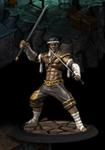
Information about
The Warlock of Firetop MountainDeveloper: Tin Man Games
SP/MP: Single-player
Setting: Fantasy
Genre: Adventure-RPG
Combat: Turn-based
Play-time: Up to 10 hours
Voice-acting: None
Regions & platforms
Internet
· Homepage
· Platform: PC
· Released: 2016-08-31
· Publisher: Tin Man Games
More information
Summary
Pros
- Nostalgic blending of core game-book experience
- Faithful to the source material
- Fun and simple combat system
- Personal quests encourage replayability
- Attractive to explore; great atmosphere
Cons
- Mildly repetitive leading to stale encounters
- Possibly too simple; lack of challenge long term
- Some bugs still need stomping
- Some fighting rules are absent
- Weak implementation of Maze of Zagor


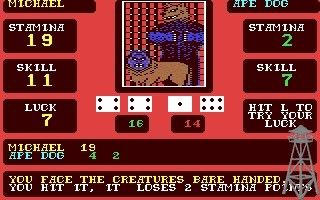
.jpg)
